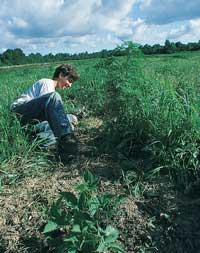|
Around
Tappan Square
 The
Makings of an Environmental Classroom The
Makings of an Environmental Classroom
The
Ecological Design Innovation Center maps out a land laboratory
by Yvonne Gay
“It
looks like we’ve had a little water damage here,” says
Brad Masi, rubbing his hand over the rough surface of the clay and
straw bale walls of the five-month-old greenhouse. He discovers
that the fibers in the tarp that had been protecting the walls have
started to break down, letting in moisture.
The
greenhouse is Masi’s second straw bale construction. The 1993
Oberlin graduate directs the Ecological Design Innovation Center
(EDIC), a non-profit organization working with the College to promote
sustainable land-use in Northeast Ohio. In 1999 he supervised construction
of a straw bale tool shed at Oberlin’s Eastwood Elementary
School.
Located a mile east of Oberlin, the experimental greenhouse sits
on 70 acres of property acquired by the College in the mid-1980s.
EDIC has leased the land since 1999, working to develop new approaches
to food, shelter, energy, and habitat. A sign of things to come,
the 20 x 96-foot hoop greenhouse combines natural building design
and organic crop production.
The greenhouse held up well during Ohio’s hottest days last
summer and withstood bouts of heavy, unpredictable rain showers
in October. Supporting the structure are two straw bale walls assembled
atop cinder blocks at both ends of the greenhouse. Sheets of clear
plastic drape the entire building and can be rolled up at the base
for ventilation.
The greenhouse was erected in part by participants in a natural
home construction workshop. “The air quality in a naturally
constructed home is much better than one with man-made materials,
because the chemicals used in furniture, paint, carpet, and compressed
woods emit gases that can make people sick,” says Sadhu Johnston
’98, founder of the Cleveland Green Building Coalition (GBC)
and co-organizer of the workshop. (GBC is applying strategies from
the College’s Environmental Studies Center to renovate a historic
office building in downtown Cleveland.)
In drafting plans at EDIC’s site that are compatible with its
ecology, faculty and student interns studied soil quality, elevation,
hydrology, and biodiversity. EDIC’s board of directors, which
includes Danforth Professor of Biology David Benzing and environmental
studies director David Orr, mapped out uses for the property, which
could include a restored century barn, wind energy generators, blueberry
crops, small livestock, a hydrogen fuel cell, and an expansion of
existing beekeeper hives.
The site’s proximity to the College makes it an ideal land
laboratory for environmental studies and biology students. Already
students in assistant professor John Petersen’s systems ecology
courses are performing preliminary wetland studies.
“College students tend to get a lot of information without
learning the processes,” explains Petersen ’88. “By
getting them involved at the land-use site, we’re training
better scientists. Not all experiments work. I want to use [the
land] as an educational facility for my classroom.”
Yet another manifestation of EDIC’s vision was the decision
to lease part of its land to the Oberlin Sustainable Agriculture
Project (OSAP), a community-supported organic farming organization.
OSAP will run an organic farm at the property, where the greenhouse
is expected to add two months to its growing season.
“The idea is to show local farmers that they don’t have
to sell their property to construction companies,” Benzing
said. “We’re also trying to show growers how they can
use their land without chemicals.”
“Ideally we would like to add a processing center for canning
and preserving food,” Masi says. “Our current OSAP organic
farm has a three-week period in late summer to chase markets for
10,000 pounds of tomatoes. Many of these tomatoes go to waste. If
they could be turned into sauce or salsa, it would open up a new
market and extend the seasonal availability of organic produce.”
The College has helped OSAP’s efforts; by June it will have
purchased $5,000 of organic produce—a move made in large part
from students’ demands to buy local.
First, however, EDIC must restore depleted topsoil at the site’s
farmland. “Without fertile ground, none of our larger plans
can take hold,” Masi says. “This project will demonstrate
how we can restore the ecological potential of our landscape.”
|



 The
Makings of an Environmental Classroom
The
Makings of an Environmental Classroom